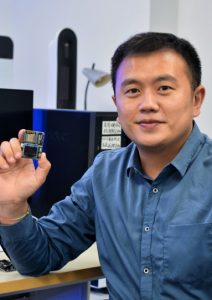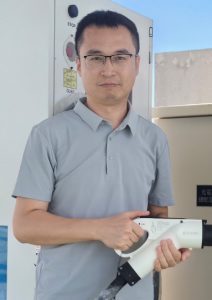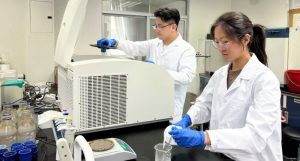Guided by the ‘dual carbon’ strategy and the vision of creating livable, resilient, and sustainable smart cities, the University of Macau (UM) is advancing ecological research tailored to the region’s characteristics. The university focuses on two key areas: developing integrated energy systems to achieve carbon neutrality in smart cities, and studying the regional marine environment. These efforts align with the United Nations Sustainable Development Goals (SDGs), specifically SDG13 (Climate Action), SDG6 (Clean Water and Sanitation), and SDG14 (Life Below Water). They also support Macao’s goals of reaching carbon peak emissions by 2030 and achieving deep decarbonisation in the power and transport sectors by 2050.
Innovations in Energy Regulation
Electricity makes up more than 60% of Macao’s total energy consumption, with the commercial sector being the largest user. In addition, about 90% of the city’s electricity is imported. In this context, achieving carbon neutrality in Macao requires a comprehensive strategy that considers local power generation, imported electricity, and energy consumption in the building and transport sectors. To tackle these challenges, UM, through the State Key Laboratory of Internet of Things for Smart City (SKL-IOTSC), is leveraging advanced technologies, such as the Internet of Things (IoT), big data, and artificial intelligence (AI), to help transform Macao’s power distribution networks and optimise demand-side energy management, which are key steps towards achieving carbon neutrality.
Traditionally, power systems have operated under a ‘source follows load’ model, where electricity generation passively responds to demand. However, as renewable energy sources are integrated on a larger scale, this model struggles to maintain grid stability and meet carbon reduction goals. Yonghua Song, rector of UM and director of SKL-IOTSC, was among the first to propose a new ‘load follows source’ model. This innovative approach shifts the focus of regulation from power generation to demand-side management, allowing electricity consumption to adjust more dynamically to the availability of renewable energy. This model facilitates the utilisation of intermittent sources such as wind and solar power while ensuring safe and cost-effective operation of the grid. For example, commercial buildings can adjust air-conditioning systems by taking advantage of their thermal inertia, and electric vehicles (EVs) can be charged during off-peak hours. By tapping into these invisible resources, the model plays a vital role in advancing SDG13 (Climate Action).
Decarbonising Urban Power Systems
Cities across the Greater Bay Area, including Macao, are experiencing rapid economic growth, large populations, and high power load density. Moreover, public buildings such as hotels and office towers are densely packed and highly energy-intensive, creating an urgent need to enhance grid reliability and develop low-carbon, energy-efficient regulation strategies. A research team led by Hui Hongxun, assistant professor in SKL-IOTSC, has made important progress in addressing these challenges. The team has developed ‘IoT-based regulation technologies for flexible loads in urban power grids’, achieving breakthroughs in holographic information sensing, time-varying building modelling, and optimised scheduling control.
The team’s approach integrates both the electrical characteristics of flexible resources and non-electrical factors such as external environmental conditions, occupant comfort, and building thermal inertia. This method has enabled the development of advanced IoT-driven technologies for managing flexible loads in urban power systems. Key innovations include cross-district information exchange mechanisms, multi-timescale modelling techniques, and quantitative tools for assessing regulation capacity. In addition, to address the increasing connection between the electricity market and the carbon market, the team has developed resource scheduling control technologies.
These technologies were first applied on the UM campus, where the team established a smart energy hybrid real-time simulation platform. This platform integrates photovoltaic systems, energy storage, charging systems, and centralised cooling resources, enabling microsecond-level real-time regulation of the campus power system. According to Prof Hui, the platform has helped reduce UM’s energy costs by about 10%, providing a practical ‘UM model’ for urban carbon reduction. Beyond the campus, the team has also supported Shenzhen in developing a ‘building energy consumption monitoring platform’ and a ‘controllable load resource management platform’. Leveraging Shenzhen’s ‘dual carbon’ platform, their work has been deployed across multiple building clusters in the city, improving grid regulation capabilities and integration of renewable energy. These efforts are helping transform Shenzhen into a low-carbon city in the Greater Bay Area.
Smart Regulation of Electrified Transport and Power Grids
Around 25% of Macao’s direct carbon emissions come from its land transport system. To reduce these emissions, the electrification of land transport has become a key focus of the Macao SAR government’s Long-term Decarbonisation Strategy. At UM, research teams are working on EV charging load modelling and analysis, charging and discharging control, and charging infrastructure planning. In collaboration with Companhia de Electricidade de Macau (CEM), the university has developed the Macao Smart Charging Management Platform to optimise the city’s charging infrastructure. Partnering with China Southern Power Grid, UM has also pioneered technologies for large-scale, orderly EV charging and discharging control, along with solutions to improve the resilience of power systems. These innovations have been implemented in Guangdong and Hainan, contributing to the joint advancement of SDG7 (Affordable and Clean Energy) and SDG13 (Climate Action).
The operational efficiency of power distribution networks—often referred to as the ‘capillaries’ of urban power systems—is critical to achieving decarbonisation goals. However, in Macao and other cities in the Greater Bay Area, high load densities, complex grid structures, and limited operational flexibility pose significant challenges. To address these issues, UM researchers have leveraged AI and big data-driven technologies to develop solutions. According to Zhang Hongcai, associate professor in SKL-IOTSC, his team has deleloped ‘data-driven non-parametric techniques for energy system operation and control’, an innovative approach that helps modernise distribution networks. Unlike traditional methods that depend on precise physical parameters, these AI-based techniques enable precise modelling and intelligent control of complex urban grids. By enhancing the ability of power networks to accommodate distributed solar and wind power as well as the growing demands for EV charging, these innovations support the safe, efficient, and low-carbon operation of urban power systems.
Successful Implementation in Hengqin
UM’s innovative technologies have proven their value in the Guangdong-Macao In-Depth Cooperation Zone in Hengqin. In collaboration with the State Power Investment Corporation Limited, UM researchers have applied data-driven technologies to optimise the operation of centralised cooling systems, enabling smart and efficient district-level energy management. According to Prof Zhang, the project leader, the system uses ice thermal energy storage technology to balance energy demand. Energy is stored by producing ice during off-peak hours and is released during peak periods as the ice melts to provide cooling. This approach not only reduces strain on the power grid during high-demand periods but also takes advantage of lower-cost electricity when demand is low.
In 2023, the system successfully reduced overall energy consumption at the No 3 Energy Station of the district cooling system in the Cooperation Zone by 6%, while lowering electricity costs by 11.45%. Reflecting on the project’s broader impact, Prof Zhang says, ‘As collaboration in the energy and power markets continues to deepen across the Greater Bay Area, this technology will help drive district energy systems towards lower carbon emissions and greater intelligence, supporting the gradual achievement of carbon neutrality in urban areas.’
Regenerating Water Resources: Turning Waste Into New Value
As a coastal city, Macao’s livability is closely connected to its marine environment. In light of this, UM has established the Centre for Regional Oceans to advance research on marine pollution prevention and control. The centre aims to improve water quality in coastal cities, promote cleaner urban environments, and safeguard public health.
A research team led by Hao Tianwei, associate professor in the Department of Civil and Environmental Engineering and the Centre for Regional Oceans of the Faculty of Science and Technology, focuses on developing technologies for wastewater purification and resource recovery. One of their key achievements is the ‘in-situ coagulation-electrochemical oxidation system’, which represents a major improvement over conventional biological and/or chemical coagulation-based wastewater treatment approaches that often struggle to handle highly concentrated and persistent pollutants. This system integrates electrochemical and electrocoagulation processes to effectively remove resistant organic compounds, phosphorus, nitrogen, and heavy metals. It increases purification efficiency by three to ten times while reducing treatment costs by 50%. Suitable for treating various types of wastewater, including landfill leachate and textile industry effluent, the system is now being scaled up for pilot testing and early commercialisation.
For sludge treatment, the team has developed a system to recover high-value resources from sewage sludge produced by municipal sewage treatment plants. Using a series of innovative extraction technologies, researchers recover sulphated polysaccharides (which have anti-tumour and anticoagulant potential) and industrial-grade sodium alginate from municipal sludge. The system improves sludge dewatering efficiency by 80% and transforms waste into valuable materials. To address public concerns about using sludge-derived materials for medical purposes, the team adopted a ‘take from water, use in water’ approach— repurposing the sulphated polysaccharides as fish feed additives (formulated with 0.5% sulphated polysaccharides). Experiments have shown that fish such as large yellow croaker, black sea bream, and yellow croaker, when fed with this additive for three to four weeks, have significantly higher survival rates under bacterial and viral exposure, creating new opportunities for sustainable aquaculture and marine ecosystem protection.
In addition, the team has developed a ‘real-time automatic volatile fatty acid (VFA) and alkalinity analyser’ to support the fermentation of residual sludge after polysaccharide extraction for VFA production. This innovative device can complete analysis in just three minutes—making it ten times faster and 90% cheaper than traditional equipment, while maintaining high accuracy. It has already been used in several wastewater treatment plants in Hong Kong, providing an effective monitoring tool for the anaerobic digestion industry. Reflecting on the team’s achievements, Prof Hao says, ‘Our close collaboration with universities and enterprises in neighbouring regions provides strong support for both research innovation and practical application. This reflects UM’s strength as a university rooted in Macao while serving the wider region.’
From optimising energy demand management and enhancing power system reliability, to advancing comprehensive water resource management, UM is driving ecological sustainability across Macao and the region through multidimensional technological innovation. As research deepens and regional collaboration grows, these technologies are poised to make a greater impact—advancing global sustainability goals in renewable energy and environmental protection.
Text: Gigi Fan, Stella Kuan
Photo: Editorial board, with some provided by the interviewees
English Translation: Gloria Kuok, Bess Che
Source: UMagazine Issue 32
Related articles:
Advancing Social Wellbeing Through Research and Innovation
Fostering Innovation to Drive Economic Diversification and Industry Transformation


Prof Hui Hongxun

The smart energy hybrid real-time simulation platform provides a pratical ‘UM model’ for urban carbon reduction

Prof Zhang Hongcai

UM researchers use AI‑based technologies to achieve intelligent control of power grids

Prof Hao Tianwei

UM successfully extracts sulphated polysaccharides from sludge
